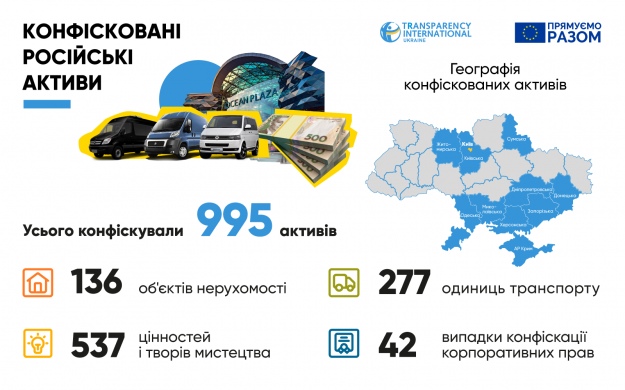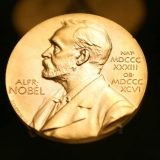Guilty! What was confiscated from aggressor in 500 days of war and how
Russia's full-scale war against Ukraine has been going on for more than 500 days. According to the World Bank, on the controlled territory of Ukraine alone, the losses caused by the aggressor amount to more than EUR 400 bln, and after the liberation of the entire territory of our state from the invaders, this amount will double.
Voluntary compensation by the aggressor country for reparations is unlikely; therefore, a more practical way is to confiscate the assets of russia, its citizens, companies, and traitors who support the putin regime.
Unfortunately, we cannot quickly reach all russian assets concentrated in different countries of the world. However, we can and must confiscate the assets of the aggressor and its accomplices on the territory of our state.
It is in order to identify progress on this difficult path that we at Transparency International Ukraine have analyzed all the available cases regarding the confiscation of russian assets and presented them on our online platform How to Confiscate Russian Assets in Ukraine? This allowed us to understand whether Ukraine managed to become a leader and an example for international partners in the processes of confiscation of russian property in more than a year of the full-scale war.
How were the assets confiscated?
Currently, Ukraine has 3 mechanisms that can be used to recover russian assets.
The first and most fruitful is confiscation within the framework of imposing sanctions on a person.
As of July 5, we already have 23 decisions of the High Anti-Corruption Court on the recovery of assets of Kremlin's accomplices into the national income. Among the sanctioned individuals are Russian oligarchs Oleg Deripaska, Vladimir Yevtushenkov, Mikhail Shelkov, and putin's close friends Igor and Arkady Rotenberg.
The second mechanism is the forcible seizure of objects of property rights of russia and its residents. This mechanism was used for the first and last time in May 2022, when the assets of two subsidiaries of the russianSberbank and VEB.RF were recovered.
The third mechanism is confiscation within criminal proceedings. This method has been tested in practice and seems to be the best one but is marked by an extremely narrow focus. It applies only to persons who have committed crimes for which the Criminal Code provides for punishment in the form of confiscation of property. These, of course, are not all the crimes committed by the russian henchmen in Ukraine.
Another feature of this method of confiscating russian property is that the consideration of such cases takes a lot of time — sometimes it can last up to a dozen years. Probably, that is why there has been only one case of seizing enemy assets under this mechanism.

What was confiscated?
Within the framework of the sanctions mechanism, as of July 5, 993 objects of property rights were confiscated. Among them are cars, real estate, corporate rights, and even works of art, by the way, from the residence of Yanukovych. Among the largest enterprises whose shares were recovered into Ukraine’s income are Demurinsky Mining and Processing Plant LLC, Mykolaiv Alumina Plant LLC, and Hlukhiv Quartzite Quarry LLC.
However, so far, none of the confiscated objects have been sold, and, accordingly, not a single penny of them has been transferred to the Fund for the Elimination of the Consequences of Armed Aggression of russia. This is primarily due to the fact that it took the parliament and the government quite some time to decide which body can be entrusted with the management and sale of confiscated assets.
Only in June, the Verkhovna Rada adopted draft law 8250, which empowered the SPFU to manage sanctioned assets on a permanent basis. However, during the second reading, a harmful amendment was introduced to the draft law, which in fact blocked the possibility of selling (pro-)russian assets, so now MPs have less than three months to correct such a bug.
54 confiscated objects are located in the Autonomous Republic of Crimea and Donetsk Oblast. Since these territories are still under russian occupation, it is not yet clear how the authorities plan to enforce such decisions on confiscation.
As for the assets forcibly withdrawn from banks, these include their property, as well as the rights to claim the bank's debt, domestic government bonds, certificates of deposit, and other financial assets.
Thanks to this seizure, UAH 25.8 bln was transferred to the Fund for the Elimination of the Consequences of Armed Aggression of russia — and this is almost the first "live" money that was channeled to the budget after the confiscation of (pro-)russian assets.
Last but not least, criminal cases. As we mentioned above, since the beginning of the full-scale war, there has been only one case of confiscation of assets related to russia and its accomplices. But it is noteworthy that the authorities have to some extent parallelized this process, and a number of assets seized within the framework of criminal proceedings have already been confiscated under the sanctions mechanism. For example, this is how the property of Shelkov, Yanukovych, Deripaska, Giner and the father and son Rotenbergs was alienated.
Are there any risks that something will go wrong?
Yes, there are. First of all, we are talking about the possibility of appealing against the confiscation of their property by russian henchmen in international instances. If such an appeal is successful, Ukraine may be obliged to return the confiscated assets or reimburse their value to the owners — no matter how much damage these persons have done to our country.
For example, the European Convention on Human Rights protects the right to property (Protocol 1, Article 1), and also guarantees everyone the right to a fair trial (Article 6) and the right to an effective remedy (Article 13).
There are procedural shortcomings in the sanction mechanism; because of that, the whole process can be recognized as violating these provisions of the Convention. In particular, this type of confiscation does not guarantee mandatory notification of third parties about the consideration of the case, the terms of consideration of the case by the High Anti-Corruption Court remain too short, as well as the terms for filing a defence and appealing the decision of the first instance. We are talking about a potential violation of the rights not only of defendants, but also of third parties, which are often Ukrainian enterprises.
Recently, the HACC Appeals Chamber has canceled the confiscation of two quarries that were allegedly indirectly owned by Oleg Deripaska. Ukrainian entrepreneurs managed to refute the connection between the quarry and the russian oligarch. Such decisions indicate that the sanctions mechanism still needs to be worked on, not only to effectively collect russian assets, but also not to harm the Ukrainian ones.
The only case of forcible seizure of assets of russian banks is also appealed in international arbitration. It is not yet known whether this arbitration process has ended. The fact that this mechanism does not provide for any judicial or administrative proceedings, which may also be a potential violation of Article 13 of the ECHR, raises concerns.
Confiscation under criminal law has the least risk of appeal, but so far, there has been only one case of confiscation of assets belonging to collaborator Yevhen Balytskyi. There are many reasons why this mechanism yields so few results. Among them, in particular, are procedural features — lengthy consideration, high standard of proof, etc.
However, to improve the situation, it is also necessary to raise the issue of the activity and effectiveness of law enforcement agencies and courts. Now more than ever, it is important to mobilize all efforts to not only take property from criminals, but also to bring them to criminal responsibility. Confiscation does not replace punishment but complements it.
In addition, in the Criminal Code, not all articles provide for the confiscation of property. Therefore, it is necessary to criminalize the circumvention of sanctions. We are talking about updating the Criminal Code in terms of recognizing the circumvention of sanctions imposed on a person as a crime and providing for the confiscation of assets along with the main punishment. This would make it possible to confiscate even those assets that have not yet been seized in sanctions cases. In particular, we are talking about the Khust and Zhezhel quarries, which are allegedly associated with Deripaska.
***
Therefore, all risks in all confiscation mechanisms can and should be neutralized. It is also necessary to improve the existing mechanisms, considering the experience of their implementation. To this end, firstly, political will is crucial, as it is always the case.
Secondly, legal technique is of importance. Currently, a number of draft laws aimed at improving confiscation mechanisms are registered in the parliament, but all of them need to be finalized. Sadly, they haven't even been on the agenda for a month.
If we count on the support of international partners in this area, Ukraine should undoubtedly be the most effective in the process of confiscating russian assets. We will continue to track all successes and failures in this area and share the results, including on our online platform.
Nataliia Sichevliuk, Legal Advisor at Transparency International Ukraine






